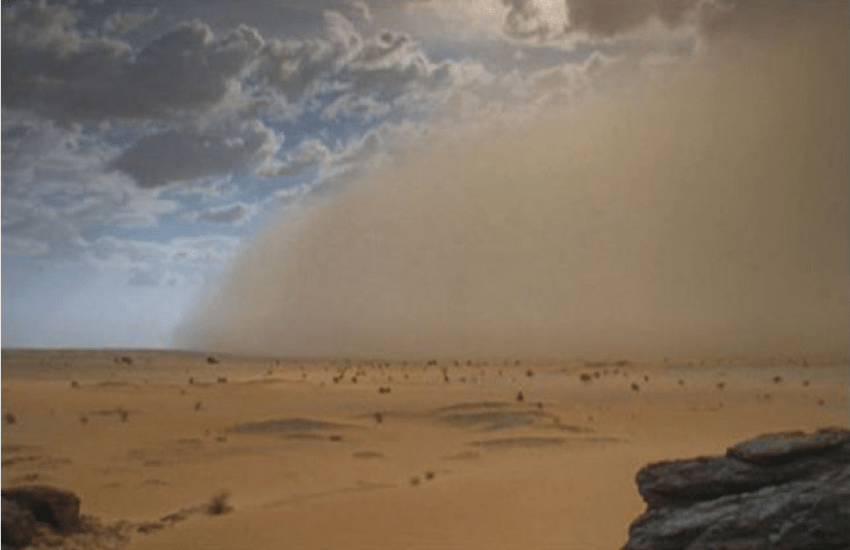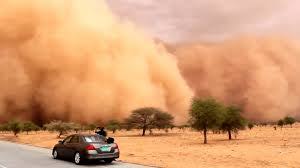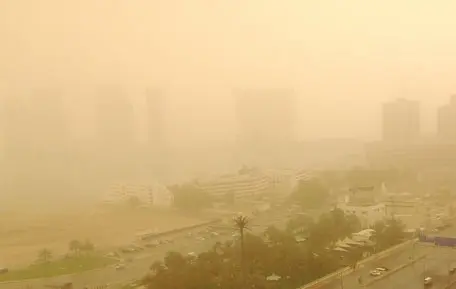- July 11, 2025
- Posted by: Hub Admin
- Categories: Article, Climatic Justice, Economic Development, Environmental Protection, Human Rights

By Pamela Udejimba
Sand and dust storms (SDS) occur when strong wind currents lift large quantities of fine soil and mineral particles from dry, bare surfaces and transport them across vast distances. These storms originate primarily in arid and semi-arid regions such as the Sahara, Arabian, and Gobi deserts, but their effects can be felt thousands of kilometres away, affecting air quality, weather patterns, and ecosystems. The Sahara Desert’s storms significantly affect Nigeria, particularly during the harmattan season. The harmattan is a dry, dusty wind that blows from the Sahara Desert into West Africa, including Nigeria, bringing dust and sand.
Impacts of Sand and Dust Storms

SDS have significant impacts on health, the environment, and the economy. Fine particulate matter affects the respiratory tract and can enter the bloodstream, exacerbating asthma, bronchitis, cardiovascular disease, and other serious health conditions. Hospitals in Nigeria’s northern states regularly report spikes in respiratory-related admissions during peak harmattan months, stretching limited resources and placing additional burdens on vulnerable populations. Dust particles also irritate the eyes, causing conjunctivitis and other illnesses, and the skin, leading to dryness and abrasion. For children and the elderly, who are already at higher risk from environmental stressors, these consequences can be life-threatening.
Repeated removal of nutrient-rich topsoil diminishes agricultural productivity and accelerates land degradation, contributing to desertification. Dust settles on water surfaces, reducing clarity and disrupting aquatic ecosystems upon which local communities depend for fishing and irrigation. Flora and fauna adapted to specific soil and moisture regimes may decline as dust alters habitat conditions, threatening biodiversity in regions already stressed by deforestation and overexploitation of resources.
Damage to crops and livestock can slash farm yields by up to 30–40% in severely affected areas, exacerbating food insecurity among rural communities. Transport networks are also affected as reduced visibility leads to flight cancellations, road accidents, and logistical delays, driving up costs for businesses and consumers alike. Even the renewable energy sector is not spared: solar panels and outdoor machinery accumulate dust, reducing efficiency and increasing maintenance demands. In Nigeria’s rapidly growing economy, these disruptions ripple through supply chains and slow the nation’s development progress.
Drivers of Sand and Dust Storms in Nigeria
At the root of Nigeria’s SDS challenge are both natural drivers, such as the seasonal harmattan winds and climate-induced shifts in rainfall patterns and human activities. Unsustainable agricultural practices, including over‑tillage, removal of protective vegetation cover, and improper irrigation, expose soils to wind erosion. Vast tracts of forest are cleared for fuelwood, depleting natural windbreaks that once stabilised the land. Rapid urbanisation, often managed without sufficient green infrastructure, increases impervious surfaces and erosion hotspots on city fringes. Meanwhile, climate change acts as a force multiplier: rising temperatures, prolonged droughts, and irregular precipitation cycles leave soils parched and more susceptible to mobilisation by winds.

Policy and Institutional Frameworks for Combatting Sand and Dust Storms in Nigeria
Nigeria’s response is anchored in a robust policy and institutional framework. Under the United Nations Convention to Combat Desertification (UNCCD), the National Action Plan to Combat Desertification emphasises mapping and monitoring of high-risk zones, capacity building for local authorities and community groups, and the promotion of research to develop agro‑ecological solutions. Complementing this, the National Agency for the Great Green Wall (NAGGW) leads Nigeria’s contribution to the African Union’s ambitious initiative to restore degraded lands across the Sahel‑Savannah belt. Through afforestation and reforestation efforts, the establishment of shelterbelts, and community-driven nursery management, NAGGW is transforming barren areas into resilient landscapes that sequester carbon, support biodiversity, and buffer against advancing sands.
Integration with international frameworks further enhances Nigeria’s resilience strategy. The Sendai Framework for Disaster Risk Reduction 2015–2030 embeds SDS mitigation within national disaster risk reduction plans, while alignment with the Sustainable Development Goals (SDGs) ensures that actions to combat dust storms contribute to broader objectives: achieving zero hunger (SDG 2) through resilient agricultural systems, promoting good health and well‑being (SDG 3) by reducing disease burdens, supporting climate action (SDG 13) through adaptation and mitigation measures, and preserving life on land (SDG 15) via ecosystem restoration.
The Significance of Cross‑Sectoral Collaboration, International Cooperation, and Community Engagement in Combatting Sand and Dust Storms in Nigeria
Real progress, however, depends on cross-sectoral collaboration. Agricultural stakeholders need to champion climate-smart practices such as conservation tillage, cover cropping, and agroforestry, which integrate trees into farming systems to stabilise soils, enhance water retention, and diversify household incomes through fruit, fodder, and fuelwood production. Pastoral communities need to adopt rotational grazing to maintain vegetative cover and prevent overgrazing. In the health sector, deployment of low-cost air quality sensors can enable communities and policymakers to access real-time data, triggering public health campaigns that distribute protective masks and educate citizens on behaviours such as reducing outdoor activities during dust events. Urban planners and engineers can also explore dust-resilient building designs that incorporate airtight windows, vegetation buffers, and air filtration systems, alongside policies to expand green spaces in rapidly growing cities like Lagos and Abuja.
International cooperation further amplifies these national efforts. As a member of the United Nations Coalition on Combating Sand and Dust Storms, which brings together 20 UN and non-UN agencies, Nigeria participates in mapping dust source areas, crafting policy frameworks, sharing best practices, and strengthening regional early warning systems. This coalition, co‑chaired by the UN Economic and Social Commission for Western Asia (ESCWA) and the UN Economic and Social Commission for Asia and the Pacific (ESCAP), fosters knowledge exchange between countries that face similar challenges, from North Africa and the Middle East to Central Asia and beyond.
Yet, policy and technology alone are insufficient without strong political will and community engagement. The International Day of Combating Sand and Dust Storms serves as both a spotlight and a catalyst: a spotlight on the interconnected threats of environmental degradation, climate change, and public health; and a catalyst for collective action that transcends traditional sectoral boundaries. All levels of society, governments, private sector actors, civil society organisations, research institutions, and local communities must collaborate to scale up effective interventions, mobilise resources, and ensure that vulnerable populations are not left behind.
Conclusion: A Call to Action
For Nigeria, the path forward begins with education and awareness. Schools, universities, and community centres offer platforms for workshops, seminars, and youth-led initiatives that teach sustainable land management and highlight the health risks of dust exposure. National media campaigns can elevate public understanding of SDS, while social media and mobile technology facilitate rapid dissemination of warnings and best practices. At the grassroots level, women’s groups, farmer cooperatives, and pastoral associations bring local knowledge and ingenuity to bear, adapting global recommendations to the realities of daily life in Nigeria’s diverse agro‑ecological zones.
Let this International Day of Combating Sand and Dust Storms be a renewed pledge: to work collaboratively, to innovate boldly, and to sustain the ecosystems and the people they support for generations to come. Together, we can protect our shared planet, and build a more resilient, sustainable future for all.
